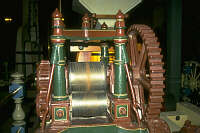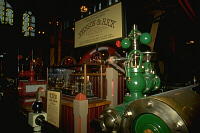![[Photo of Smithsonian Arts and Industry Building]](photos/cm_phil05.200.jpg)
![[INTERNET 1996 WORLD EXPOSITION]](/Images/fair_header.gif)
While there had been a few half-hearted attempts before, the U.S. entry into the world's fair sweepstakes came on the 100th anniversary of the birth of the republic. Philadelphia was the natural site for this Centennial Exhibition, which centered on a vast machinery hall, holding 13 acres of new devices, widgets, and gadgets.
One of the most popular exhibits in the Machinery Hall was a prototype slice of the cable that Roebling Brothers would use for the Brooklyn Bridge. They would end up using 6.8 million pounds of these first galvanized cables, covered with Zinc and with a strength of 160,000 pounds per square inch (double that of the iron wire used at Niagara).
The Machinery Hall also featured other novelties, such as the first typewriter and a telephone. The Emperor Dom Pedro of Brazil put Bell's strange device to his ear, then quickly dropped it, exclaiming "My God, It talks!" [footnote here]
 Telephones and typewriters were nice, but what people wanted
was power. Towering over the hall was the gigantic Corliss
Steam Engine, taller than a house, powering 13 acres of
machinery in the great hall.
The 1500 horsepower double Corliss steam engine connected
to 5 miles of shafting used to move this power throughout
the vast machinery hall.
[Hunter,, pp. 207-208]
Telephones and typewriters were nice, but what people wanted
was power. Towering over the hall was the gigantic Corliss
Steam Engine, taller than a house, powering 13 acres of
machinery in the great hall.
The 1500 horsepower double Corliss steam engine connected
to 5 miles of shafting used to move this power throughout
the vast machinery hall.
[Hunter,, pp. 207-208]
On opening day, the hall was full of people, but dead silent as President Ulysses S. Grant and the Emperor Dom Pedro of Brazil climbed up on the engine platform and hit the levers that allowed steam into the cylinders. The engine hissed and the floor trembled. Then, the huge walking beams slowly started moving up and down, feeding the giant flywheel which spun around, gaining momentum and storing energy. Then, belts started moving, and shafts and pulleys started turning as power went out into the hall.
 The amount of activity in the hall boggled people's minds. The
New York Herald, the Sun, and the Times all printed their daily
editions in the hall. Machines started sewing, pins got stuck
into paper, wallpaper printed, logs were sawed. What really
amazed people, though, was the Corliss Engine. The machine
had only one attendant, who sat calmly on the platform and
read newspapers.
[McCullough,, pp. 351-352]
Clasp lockers (they weren't called zippers for 30
more years) were shown in Chicago in 1893 by the inventor
Whitcomb Judson and his partner Lewis Walker. They
paraded around in boots made with
the clasp locks, a tradition that is reminiscent of the
current velcro and sneaker fad.
The next year they formed the Universal Fastener Company and
the modern zipper came into being.
[Petroski,, pp. 100-101]
The amount of activity in the hall boggled people's minds. The
New York Herald, the Sun, and the Times all printed their daily
editions in the hall. Machines started sewing, pins got stuck
into paper, wallpaper printed, logs were sawed. What really
amazed people, though, was the Corliss Engine. The machine
had only one attendant, who sat calmly on the platform and
read newspapers.
[McCullough,, pp. 351-352]
Clasp lockers (they weren't called zippers for 30
more years) were shown in Chicago in 1893 by the inventor
Whitcomb Judson and his partner Lewis Walker. They
paraded around in boots made with
the clasp locks, a tradition that is reminiscent of the
current velcro and sneaker fad.
The next year they formed the Universal Fastener Company and
the modern zipper came into being.
[Petroski,, pp. 100-101]
To preserve the results of the Centennial Exhibition, the Smithsonian Institute built it's second building on the Washington, Mall, The Arts and Industries Building still contains many replicas of the devices in the Machinery Hall, including a model of the great Corliss Engine.
Louis C. Hunter and Lynwood Bryant, A History of
Industrial Power in the United States, 1780-1930. Vol
3: The Transmission of Power
MIT Press (Cambridge, MA, 1991), p. 207-208.
David McCullough, The Great Bridge: The Epic Story of the
Building of the Brooklyn Bridge,
Touchstone Books (New York, 1972), pp. 351-352
Henry Petroski, The Evolution of Useful Things,
Knopf (New York, 1992), pp. 100-101.
Back to World Expositions
Sources
![[Unreadable Image]](/Images/htoolbar.gif)
[About the Fair] [Sponsors]
[What's New] [Guestbook]
[Toolbox]